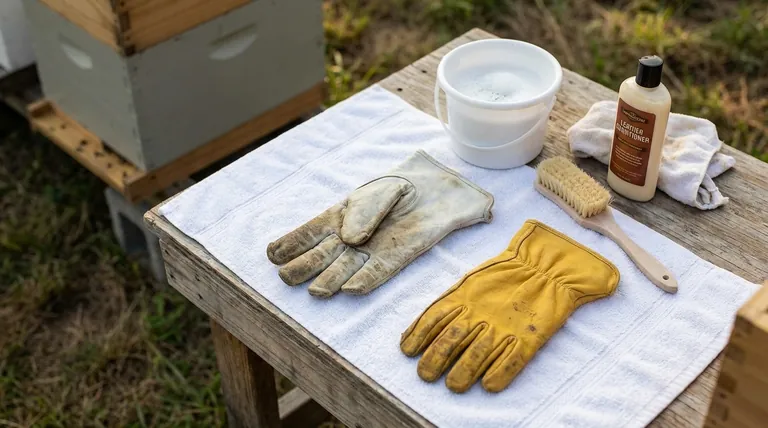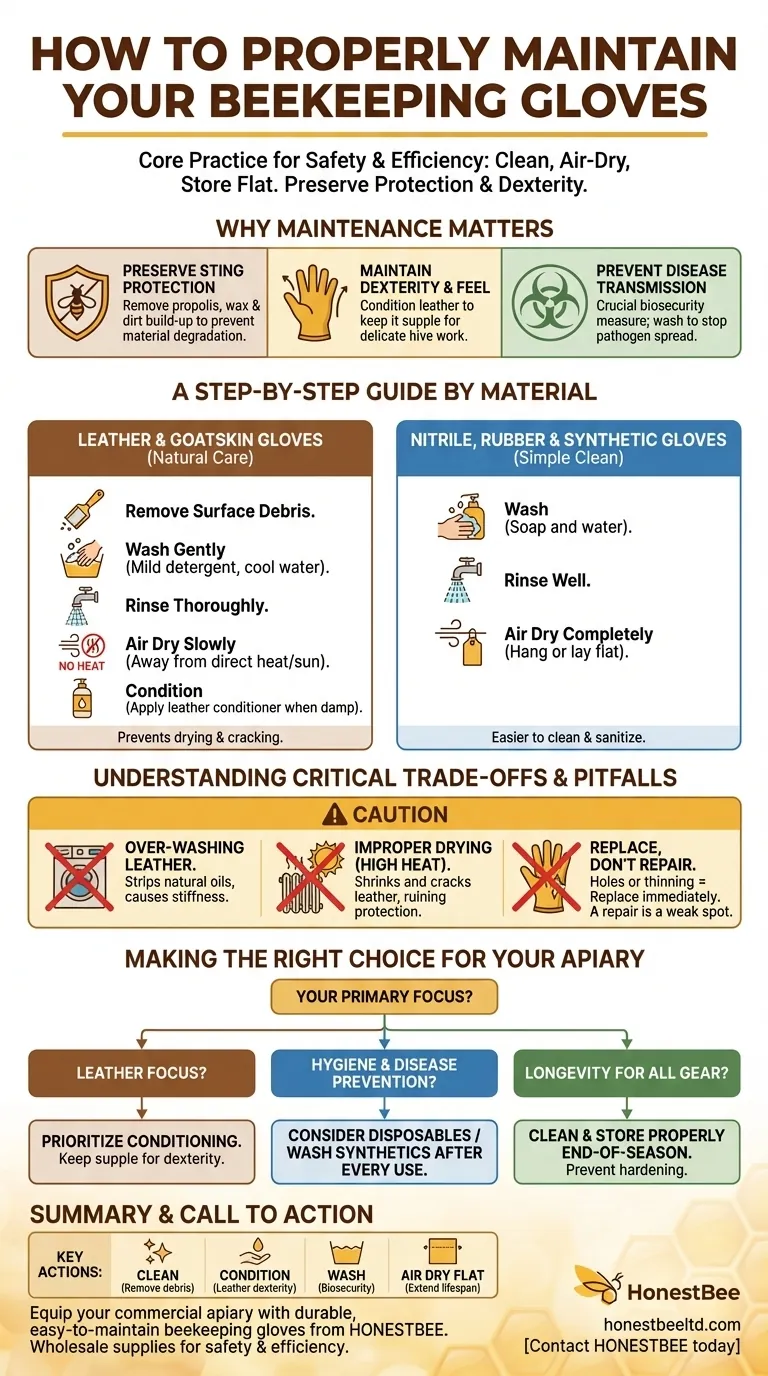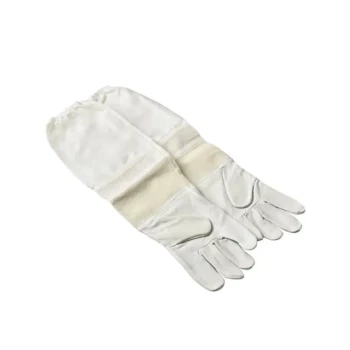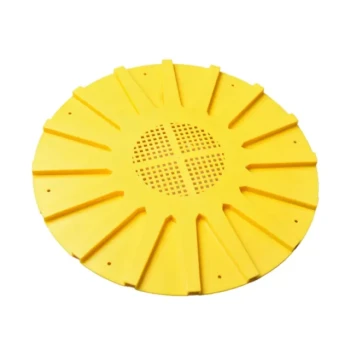To properly maintain your beekeeping gloves, you must clean them according to their material, allow them to air-dry completely, and store them flat. For leather or goatskin, use a mild detergent and water, then apply a conditioner once dry to maintain flexibility. For synthetic materials like nitrile or rubber, a simple wash with soap and water is sufficient.
The goal of glove maintenance extends beyond simple cleaning. It is a critical practice to preserve the two essential functions of your gloves: ensuring uncompromising sting protection while maintaining the dexterity required for delicate hive work.

Why Glove Maintenance is a Core Beekeeping Practice
Effective maintenance is not just about extending the life of your equipment; it's about ensuring your safety and the health of your hives.
Preserving Sting Protection
Your gloves are your primary line of defense. Over time, an accumulation of propolis, wax, and dirt can degrade the glove material, whether it's leather or a synthetic fabric.
Regular, proper cleaning removes these substances, preventing them from creating weak spots or causing the material to become brittle and prone to tearing.
Maintaining Dexterity and Feel
Beekeeping requires a sensitive touch to handle frames, inspect brood, and avoid crushing bees. Stiff, unconditioned gloves significantly reduce your dexterity.
Conditioning leather after cleaning keeps it supple, allowing you to work confidently and gently. This control is essential for efficient and calm hive inspections.
Preventing Disease Transmission
Dirty gloves can become a vector for transmitting pathogens like American Foulbrood (AFB) spores or viruses between hives.
Washing your gloves, especially after working with a hive you suspect may be unhealthy, is a crucial biosecurity measure to protect your entire apiary.
A Step-by-Step Guide by Glove Material
The correct cleaning method depends entirely on what your gloves are made of. Always check the manufacturer's instructions first.
For Leather and Goatskin Gloves
Leather is a natural material that requires specific care to prevent it from drying out and cracking.
- Remove Surface Debris: Gently scrape off excess wax and propolis.
- Wash Gently: Use a soft cloth with cool water and a small amount of mild detergent (like saddle soap). Avoid harsh chemicals.
- Rinse Thoroughly: Wipe with a clean, damp cloth to remove all soap residue.
- Air Dry Slowly: Reshape the gloves and let them air dry away from direct sunlight or heat, which can cause cracking.
- Condition: Once almost dry but still slightly damp, apply a leather conditioner to restore oils and maintain suppleness.
For Nitrile, Rubber, and Synthetic Gloves
These materials are less sensitive and easier to clean.
- Wash: Simply wash the gloves with regular soap and water, just as you would wash your hands.
- Rinse: Ensure all soap is rinsed off.
- Air Dry: Hang the gloves or lay them flat to air dry completely.
Understanding the Critical Trade-offs
Improper maintenance can be worse than no maintenance at all. Avoiding common pitfalls is key to preserving your gear.
The Problem with Over-Washing
While cleanliness is important, over-washing leather gloves can strip their natural oils, leading to premature stiffness and wear. Clean them when they become visibly dirty or sticky, not necessarily after every single use.
The Risk of Improper Drying
Never use a machine dryer or place leather gloves on a radiator or in direct sun. High, direct heat will shrink and crack the leather, ruining its protective qualities and flexibility. Patience during air-drying is essential.
When to Replace, Not Repair
Maintenance prolongs life, but it cannot fix failure. Once your gloves develop a hole, a tear, or significant thinning in the fingertips, they must be replaced. A repaired glove is a point of weakness that a bee will eventually find.
Making the Right Choice for Your Apiary
Your maintenance schedule should adapt to your equipment and the intensity of your beekeeping.
- If your primary focus is working with leather gloves: Prioritize conditioning after each wash to keep them from becoming stiff, which compromises dexterity.
- If your primary focus is hygiene and disease prevention: Consider using disposable nitrile gloves for quick inspections or when handling a sick hive, and wash reusable synthetic gloves after every use.
- If your primary focus is longevity for all gear: Clean and properly store your gloves at the end of the season to prevent propolis and honey from hardening and degrading the material over the winter.
Consistent care ensures your gloves remain a reliable tool for protection and precision in your apiary.
Summary Table:
| Maintenance Goal | Key Action | Material Consideration |
|---|---|---|
| Preserve Sting Protection | Remove propolis, wax, and dirt. | Prevents material degradation and weak spots. |
| Maintain Dexterity | Condition leather gloves after washing. | Keeps material supple for delicate hive work. |
| Ensure Biosecurity | Wash after handling a sick hive. | Prevents disease transmission between apiaries. |
| Extend Glove Lifespan | Air dry flat, away from direct heat. | Avoids cracking (leather) and material damage. |
Equip your commercial apiary or distribution business with durable, easy-to-maintain beekeeping gloves from HONESTBEE.
Proper glove maintenance is essential for safety and efficiency, and it starts with high-quality equipment. HONESTBEE supplies beekeeping supplies and equipment to commercial apiaries and beekeeping equipment distributors through wholesale-focused operations. We provide gloves and other protective gear designed for durability and ease of care, helping your operation run smoothly and safely.
Let us help you protect your most valuable asset—your beekeepers. Contact HONESTBEE today to discuss your wholesale needs and discover how our equipment supports best practices in apiary management.
Visual Guide

Related Products
- Beekeeping Gloves Goatskin Leather with Long Cotton Sleeve for Beekeepers
- Goatskin Leather Beekeeper Gloves with Vent Long Sleeve for Beekeeping Honey Bee Sting Proof Protection
- Goat Skin Leather Bee Sting Proof Beekeeping Gloves with Canvas Sleeve
- Mesh Ventilated 3 Layer Goatskin Beekeepers Gloves for Beekeeping
- Professional Galvanized Hive Strap with Secure Locking Buckle for Beekeeping
People Also Ask
- What are the arguments for and against using gloves in beekeeping? Balancing Protection and Dexterity
- Why do some experienced beekeepers choose not to wear gloves? For Superior Dexterity & Hive Welfare
- What are the advantages of goatskin leather gloves for beekeeping? Superior Sting Protection for Your Apiary
- What are the features of ventilated bee gloves? Stay Cool & Dexterous in Warm Weather
- Why is dexterity and flexibility important in beekeeping gloves? Boost Your Hive Management Efficiency



















